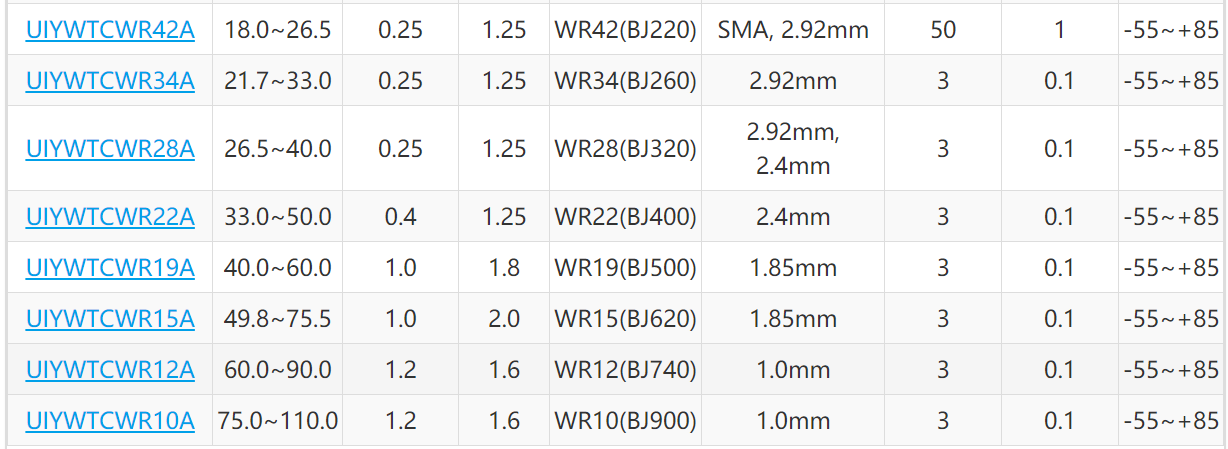Definition:
Millimeter wave (Abbr.: mmWave): The electromagnetic wave with a wavelength of 1 ~ 10 mm is called millimeter wave. It is in the overlapping wavelength range of microwave and far-infrared waves. Therefore, it has the characteristics of two kinds of spectrum.
There is no precise definition of millimeter wave frequency band, usually the electromagnetic wave in the frequency domain of 26.5 ~300GHz is called millimeter wave.
The theory and technology of millimeter wave are the extension of microwave to high frequency and the development of light wave to low frequency respectively.
Pros:
1)Very wide bandwidth.
It is generally considered that the frequency range of mmWave is 26.5 ~ 300GHz and the bandwidth is up to 273.5GHz. More than 10 times the total bandwidth from DC to microwave. Even taking into account atmospheric absorption, it is still very attractive in today’s scarce frequency resources.
2)Narrow beam.
The millimeter wave beam is much narrower than the microwave beam at the same antenna size. So small objects that are closer together can be distinguished or the details of the object can be seen more clearly.
3)Compared with laser, the propagation of millimeter-wave is much less affected by climate and can be considered all-weather capable.
4) Compared with microwave, millimeter wave components are much smaller in size. Therefore, millimeter wave system is easier to be miniaturized.
Cons:
1)The transmission attenuation in the atmosphere is serious.
2)High machining accuracy is required。
(The shortcomings of millimeter wave radar are mainly affected by atmospheric attenuation and absorption, and the current operating range is mostly limited to 10 km . Besides, compared with microwave radar, the components of millimeter wave radar have low yield in mass production at present. In addition, many devices need gold or silver coating in millimeter wave frequency band, so the device cost is high.)
Application:
5G:
The United States uses millimeter wave frequency band; In Korea, Japan and Europe, the sub-6 GHz band and millimeter wave band are deployed together.
At present, China adopts the sub-6 GHz band is mainly for 5G communication field. Such as 2.6Ghz, 3.5Ghz, 4.9Ghz, etc. Because it is too difficult to solve many key components in the mmW band, there is no choice but to choose the MEDIUM frequency. Considering that sub-6 GHz spectrum resources are very scarce in most countries (including China), it is also a trend for China to introduce millimeter wave in the future.
Other applications:
mm-wave imaging, sub-THz Chemical detector, and applications in astronomy, chemistry, physics, medicine, and security fields.
1)Automotive Radar
An important application in the imaging field is automotive radar operating at 24GHz and 77GHz. This technology helps car driving in low visibility conditions, as well as automatic cruise control and even self-driving highways in the future.
2)Millimeter wave imaging for medical applications
Another potential application of millimeter wave technology is passive mmWave imaging. An image of an object can be presented through optical system just by detecting its thermal radiation in the millimeter-wave band. Either continuously scan the target area by a set of receivers or a mobile terminal antenna (Used in Endocrinology, Orthopedics and Pain clinic)
3) Wireless transmission of HD video
4) Application in electronic countermeasures
The military requirement is an important factor to promote the development of mmWave system (it has the characteristics of narrow beam, high data rate, radio concealment, good confidentiality and anti-interference performance, quick opening, convenient and flexible use and all-weather operation).
At present, millimeter wave has been widely used in radar, guidance, tactical and strategic communication, electronic countermeasures, remote sensing, radiation measurement and other fields. Among them, Strategic communication and electronic countermeasures are very important application directions.
In electronic countermeasures, communication equipment must have strong anti-interference ability, and millimeter wave has obvious advantages in this aspect.
For example, ship-to-ship mmWave communication in 60GHz, 120GHz, 200GHz three “attenuation peak” frequency bands can greatly improve the anti-jamming and anti-interception ability by taking advantage of the characteristics of serious signal attenuation in these frequency bands.
UIY has launched a series of mmWave RF components to meet the fast growing demand in the market.
Coaxial & Drop In isolator / circulator:
Microstrip isolator / circulator:
Waveguide to Coaxial Adapter:








